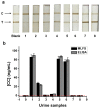Magnetic Lateral Flow Strip for the Detection of Cocaine in Urine by Naked Eyes and Smart Phone Camera
- PMID: 28587239
- PMCID: PMC5492392
- DOI: 10.3390/s17061286
Magnetic Lateral Flow Strip for the Detection of Cocaine in Urine by Naked Eyes and Smart Phone Camera
Abstract
Magnetic lateral flow strip (MLFS) based on magnetic bead (MB) and smart phone camera has been developed for quantitative detection of cocaine (CC) in urine samples. CC and CC-bovine serum albumin (CC-BSA) could competitively react with MB-antibody (MB-Ab) of CC on the surface of test line of MLFS. The color of MB-Ab conjugate on the test line relates to the concentration of target in the competition immunoassay format, which can be used as a visual signal. Furthermore, the color density of the MB-Ab conjugate can be transferred into digital signal (gray value) by a smart phone, which can be used as a quantitative signal. The linear detection range for CC is 5-500 ng/mL and the relative standard deviations are under 10%. The visual limit of detection was 5 ng/mL and the whole analysis time was within 10 min. The MLFS has been successfully employed for the detection of CC in urine samples without sample pre-treatment and the result is also agreed to that of enzyme-linked immunosorbent assay (ELISA). With the popularization of smart phone cameras, the MLFS has large potential in the detection of drug residues in virtue of its stability, speediness, and low-cost.
Keywords: cocaine; magnetic bead; magnetic lateral flow strip; smart phone camera.
Conflict of interest statement
The authors declare no conflict of interest.
Figures





Similar articles
-
Novel ractopamine-protein carrier conjugation and its application to the lateral flow strip test for ractopamine detection in animal feed.J Zhejiang Univ Sci B. 2019 Feb.;20(2):193-204. doi: 10.1631/jzus.B1800112. J Zhejiang Univ Sci B. 2019. PMID: 30666851 Free PMC article.
-
Development of a lateral flow immunoassay strip for screening of sulfamonomethoxine residues.Food Addit Contam Part A Chem Anal Control Expo Risk Assess. 2008 Apr;25(4):413-23. doi: 10.1080/02652030701561452. Food Addit Contam Part A Chem Anal Control Expo Risk Assess. 2008. PMID: 18348040
-
Cellular phone-based image acquisition and quantitative ratiometric method for detecting cocaine and benzoylecgonine for biological and forensic applications.Subst Abuse. 2010;4:21-33. doi: 10.4137/sart.s5025. Epub 2010 Sep 21. Subst Abuse. 2010. PMID: 22879741 Free PMC article.
-
Development of an immunochromatographic lateral flow test strip for detection of beta-adrenergic agonist Clenbuterol residues.J Immunol Methods. 2006 May 30;312(1-2):27-33. doi: 10.1016/j.jim.2006.02.017. Epub 2006 Apr 25. J Immunol Methods. 2006. PMID: 16678197
-
[Research and Application of Smartphone-based Detection System to Immunoassay].Zhongguo Yi Liao Qi Xie Za Zhi. 2023 Feb 8;47(2):178-184. doi: 10.3969/j.issn.1671-7104.2023.02.012. Zhongguo Yi Liao Qi Xie Za Zhi. 2023. PMID: 37096472 Review. Chinese.
Cited by
-
A Bottom-Up Approach for Developing Aptasensors for Abused Drugs: Biosensors in Forensics.Biosensors (Basel). 2019 Oct 1;9(4):118. doi: 10.3390/bios9040118. Biosensors (Basel). 2019. PMID: 31581533 Free PMC article. Review.
-
Development of a highly sensitive magneto-enzyme lateral flow immunoassay for dengue NS1 detection.PeerJ. 2019 Sep 25;7:e7779. doi: 10.7717/peerj.7779. eCollection 2019. PeerJ. 2019. PMID: 31579630 Free PMC article.
-
Ultrasensitive Magnetic Field Sensors for Biomedical Applications.Sensors (Basel). 2020 Mar 11;20(6):1569. doi: 10.3390/s20061569. Sensors (Basel). 2020. PMID: 32168981 Free PMC article. Review.
-
Hybrid paper and 3D-printed microfluidic device for electrochemical detection of Ag nanoparticle labels.Lab Chip. 2020 May 5;20(9):1648-1657. doi: 10.1039/d0lc00276c. Lab Chip. 2020. PMID: 32255136 Free PMC article.
-
Nanomaterial-based adsorbents and optical sensors for illicit drug analysis.J Food Drug Anal. 2020 Dec 15;28(4):654-676. doi: 10.38212/2224-6614.1137. J Food Drug Anal. 2020. PMID: 35696141 Free PMC article. Review.
References
-
- Floriani G., Gasparetto J.C., Pontarolo R., Goncalves A.G. Development and Validation of an HPLC-DAD Method for Simultaneous Determination of Cocaine, Benzoic acid, Benzoylecgonine and the Main Adulterants Found in Products based on Cocaine. Forensic. Sci. Int. 2014;235:32–39. doi: 10.1016/j.forsciint.2013.11.013. - DOI - PubMed
MeSH terms
Substances
LinkOut - more resources
Full Text Sources
Other Literature Sources
Research Materials
Miscellaneous

